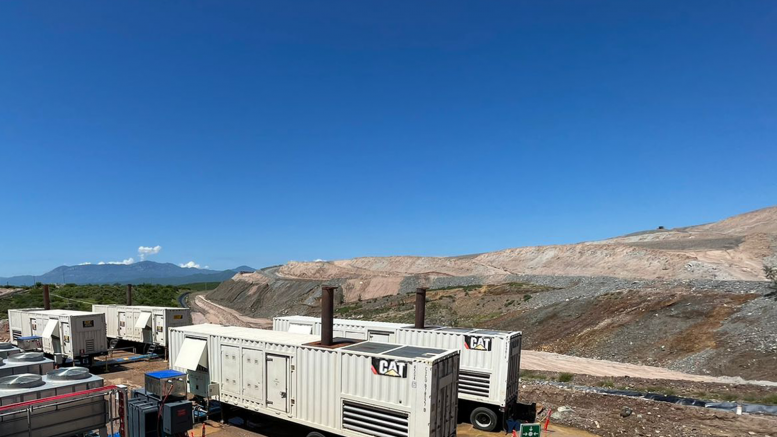Mining companies that have traditionally relied on diesel fuel for temporary power solutions can save money and reduce their carbon footprint by taking advantage of the growing accessibility of compressed natural gas (CNG) and liquified natural gas (LNG), according to Odessa, Texas-based Distributed Power Solutions (DPS).
A Caterpillar dealer with a special designation as a Global Power Provider, DPS was established in 2018 to serve customers throughout the Americas with solutions that align with the global demand for cleaner power and industry’s interest in cost savings.
“In a world where environmental issues are gaining significance, the global demand for cleaner power solutions is essential,” David Velosa, DPS’ Director of Commercial Operations said. “Governments, regulatory bodies and communities are driving a massive change in power generation, making significant emissions reduction a top priority.
“As emissions standards become more rigorous, industries like mining are faced with the challenge of maintaining or even increasing their output while adhering to these new requirements,” he added. “The traditional reliance on diesel fuel, which the mining industry has used for decades, is facing heightened scrutiny due to its considerable environmental impact.”
Tests comparing emissions from Caterpillar diesel and natural gas generators show 10 times fewer emissions using natural gas, Velosa said.
Cost advantages
Another factor driving the appeal of natural gas is price stability. Diesel prices, by comparison, fluctuate wildly because of their dependence on changes in demand by the automotive and marine industries, resulting in operational budget volatility. Natural gas pricing, on the other hand, can be negotiated through long-term agreements and contracts.

Charting energy costs of diesel fuel vs. natural gas. Credit: Distributed Power Solutions
While natural gas prices are almost always significantly lower than diesel, the exact cost difference is dependent on many factors, including the location of a mine, the amount of power needed and how long it will be required.
The use of natural gas contributes to cost savings in other ways as well, Velosa said. “Diesel engines, for example, require maintenance every 500 hours of operation. Natural gas engines, however, only require maintenance every 2,000 hours. That’s a huge difference in cost that translates into less downtime and, therefore, greater availability of production equipment.”
Diesel also poses a greater risk of spills and contamination of the natural environment, which can require costly remediation efforts.
“The use of natural gas still accounts for a small percentage of temporary power installations in the mining industry, but that’s poised to change for several reasons,” Velosa said. “The environmental and cost saving benefits are among the main drivers, but increased production of natural gas from shale, the expanding network of pipelines and the availability of CNG and LNG now make natural gas easier to source.”
Mines – especially gold, silver and nickel operations – are getting larger, and need more power, according to Velosa. “In the past, it might not have made sense for a mine requiring a 20 MW power solution to opt for natural gas because of the cost of trucking it to a remote location, but for a 200 MW or 300 MW facility, the potential savings are multiplied. For temporary power solutions of that size, it’s easy to justify the capital investment to bring in huge volumes of gas to a remote location.”
ESG priorities
Responding to pressure to boost their ESG credentials, mines are also transitioning from diesel to electrify their industrial processes and mobile equipment, including battery powered trucks, wheel loaders, tire handlers, excavators and graders that need to be charged during off-shift hours. That too increases electrical power requirements.
DPS employs a team of experts skilled in designing turnkey power solutions that prioritize both emissions reduction and cost savings. Their technical expertise covers island mode applications, microgrids, combined heat and power solutions and simple cycle gas power facilities. With access to a diverse fleet of turbine and reciprocating generators, load banks and electrical distribution systems, they are able to satisfy the objectives, constraints and preferences of their customers.
One project DPS cites as an example of a natural gas power solution for the mining industry is a silver mine in northern Mexico. To support the mine’s growing demand for power and to help it reduce costs, DPS supplied it with four Caterpillar XQ1475G natural gas engines and four medium voltage step-up transformers in two weeks following contract signing. The units run on LNG that’s trucked from 500 miles away.
“This project in Mexico is a good example of our expertise and how we collaborate with our customers to develop power solutions that balance environmental considerations, operational efficiency and cost-effectiveness,” Velosa said.
The preceding Joint Venture Article is PROMOTED CONTENT sponsored by Distributed Power Solutions and produced in co-operation with The Northern Miner. For more information visit www.dpsenergy.com.


Be the first to comment on "JV Article: Distributed Power Solutions offers natural gas energy options"